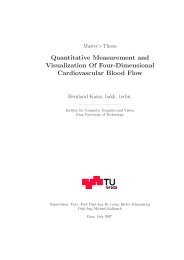CashFlow, A Visualization Framework for 3D Flow - Studierstube ...
CashFlow, A Visualization Framework for 3D Flow - Studierstube ...
CashFlow, A Visualization Framework for 3D Flow - Studierstube ...
- No tags were found...
You also want an ePaper? Increase the reach of your titles
YUMPU automatically turns print PDFs into web optimized ePapers that Google loves.
Results5.2. <strong>Cash<strong>Flow</strong></strong> Scene Graph Examplesinserts the new data into MultiData node [1]. Again the process flow points into theopposite direction to the scene graph traversal as sketched in figure 5.8. The traversalof the scene graph is continued passing the second Separator node (S) and descendingto MultiData node [4]. The nodes [4][5][6] are only empty space holders registering totheir elements. Let’s switch back to the process flow diagram in figure 5.8. The Mappernode [7] accesses the DataAccess node [2] and reads the data stored in node [1]. Usingthat data the Mapper node generates the a spherical grid by inserting a new DataAccessmap to DataAccess node [5]. The generated DataAccess map points to node [4] werethe data is stored. Also the type of grid is stored in the Grid node [6]. Since a Gridnode can only store in<strong>for</strong>mation <strong>for</strong> one grid we need three Grid nodes. The two othermapper nodes proceed the same way.Finally the traversal reaches the Render node [8]. Each Render node first requeststhe grid data from DataAccess node [5] and receives a DataAccess map pointing toMultiData node [4]. In figure 5.7 this is symbolized by the arrow, that starts at node[4] passes node [5] and ends to node [8]. The Render node also needs the topologyin<strong>for</strong>mation stored in the Grid node [6]. Same goes <strong>for</strong> the other Render nodes that arelinked to the other Grid nodes. The process flow diagram in figure 5.8 emphasizes thisprocedure also. The color map is generated on–the–fly by the Render nodes. Thiscolor map could also be created only once by another Mapper node, but this wasavoided to keep figure 5.7 as simple as possible.Applied <strong>Visualization</strong> TechniquesAfter resuming the base concepts of <strong>Cash<strong>Flow</strong></strong> some more evolved visualizations arediscussed now in detail. We will extend the scene graph from figure 5.7 on page 106.First we will create the color map only once and link all render nodes to it. Second wewill generate a height field from the raw data using another Mapper node and third wewill apply the color map to the height field. Figure 5.9 shows the resulting image intop view while in figure 5.10 the scene is rendered in side view to emphasize the heightfields.The bottom row consists of three planes in spherical, polar and Cartesian coordinateswith the color map generated from the sample values. The middle row shows thesame coordinate systems without the color map but with a height field from the samedata used from the color map. In the top row both height maps and color maps arecombined. due to the used color map low values are mapped to green, medium valuesare mapped to yellow and high values are mapped to red.In the last section we used a linear color mapping <strong>for</strong> regular grids in figure 5.10and figure 5.9.More examples with real data are presented in figure 5.11 on page 109. This is a2D flow field passing a block moving from left to right. The used grid is a rectilineargrid, which is very dense around the block. In figure 5.12 color maps are applied toplanes in <strong>3D</strong>. The used data set is the space shuttle data set from NAS NASA 1 . Coloris mapped to total energy.1 dataset from NASA at: http://www.nas.nasa.gov/Research/Datasets/data_sets.html [NAS05]107





